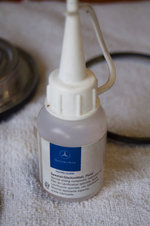Fuel Gauge Reads Inaccurately or Hangs Near Empty
This one was a bit of a stumper for me, and something that I probably would never have sorted had I not looked closely at things...
The complaint: When the fuel level got down to about 1/4 tank or lower, the gauge did not read accurately. That is, the gauge would not move to the reserve position, or if it did, it would occur suddenly such as after driving the car on rough roads. Conversely, when the tank was filled the gauge would read low for a short time after, then suddenly move up to the full position.
I removed the gauge sender from the tank and inspected it. I found that when I inverted the sender, the float would sometimes hang up near the end of the travel. If I tapped the tube or sender the float would come loose and move up to the end of the travel. Flip it over to normal orientation, and it would drop but not necessarily drop to the end of its travel.
Hmm.
Removing the tube from the float assembly indicated nothing amiss from what I could see. If I manually moved the float it would move up and down all the way without a problem, and I didn't feel any resistance to speak of near the bottom of the float's travel (empty tank). Inspection of the center rod and conducting wires showed nothing that would suggest there was a physical impediment to the float's movement.
Upon very close inspection of the float, I found the problem.
The float has two nylon "fingers" that stick out from it that act as guides for the resistance wires that the copper wipers ride on to provide a variable resistance for the gauge. These nylon fingers have a sort of "J" shape or "buttonhook" to them to keep the wires aligned with the float and wipers. One of the resistance wires had slipped out of the "J" and was rubbing or riding on the outside of it. If you look at the picture below, the wire would have been on top of the white nylon piece, not in the slot, or "J". This very slight distortion of the wire actually increased the tension on it, as the wire was no longer in a straight line. To add to this, the tension of the wire was pushing ever so slightly on the "J" shaped finger and when the float got towards the end of the travel (empty tank) the tension was greatest. This would cause the float to hang up or stick when approaching the bottom of the sender.

Once the wire was carefully placed back into the "J" there was no longer any tension on it and the float now moved freely in both directions.
When I reinstalled the float I also cleaned the cover and O rings inside of it, as I found some corrosion in the cover grooves. I also lubricated the O rings with the proper Mercedes-Benz rubber lubricant.
Dan






This one was a bit of a stumper for me, and something that I probably would never have sorted had I not looked closely at things...
The complaint: When the fuel level got down to about 1/4 tank or lower, the gauge did not read accurately. That is, the gauge would not move to the reserve position, or if it did, it would occur suddenly such as after driving the car on rough roads. Conversely, when the tank was filled the gauge would read low for a short time after, then suddenly move up to the full position.
I removed the gauge sender from the tank and inspected it. I found that when I inverted the sender, the float would sometimes hang up near the end of the travel. If I tapped the tube or sender the float would come loose and move up to the end of the travel. Flip it over to normal orientation, and it would drop but not necessarily drop to the end of its travel.
Hmm.
Removing the tube from the float assembly indicated nothing amiss from what I could see. If I manually moved the float it would move up and down all the way without a problem, and I didn't feel any resistance to speak of near the bottom of the float's travel (empty tank). Inspection of the center rod and conducting wires showed nothing that would suggest there was a physical impediment to the float's movement.
Upon very close inspection of the float, I found the problem.
The float has two nylon "fingers" that stick out from it that act as guides for the resistance wires that the copper wipers ride on to provide a variable resistance for the gauge. These nylon fingers have a sort of "J" shape or "buttonhook" to them to keep the wires aligned with the float and wipers. One of the resistance wires had slipped out of the "J" and was rubbing or riding on the outside of it. If you look at the picture below, the wire would have been on top of the white nylon piece, not in the slot, or "J". This very slight distortion of the wire actually increased the tension on it, as the wire was no longer in a straight line. To add to this, the tension of the wire was pushing ever so slightly on the "J" shaped finger and when the float got towards the end of the travel (empty tank) the tension was greatest. This would cause the float to hang up or stick when approaching the bottom of the sender.

Once the wire was carefully placed back into the "J" there was no longer any tension on it and the float now moved freely in both directions.
When I reinstalled the float I also cleaned the cover and O rings inside of it, as I found some corrosion in the cover grooves. I also lubricated the O rings with the proper Mercedes-Benz rubber lubricant.
Dan






Last edited:




